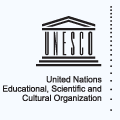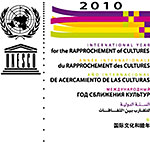Common Heritage: A Museological and Educational Approach to the Dialogue of Cultures and Civilizations
The year 2010 was the International Year for the Rapprochement of Cultures, and we continue to celebrate dialogue among civilizations, cultures and peoples worldwide. Building upon foundations of mutual understanding between different cultures, and the recognition of their equal right to dignity and respect, dialogue of cultures is intended to promote social cohesion, the reconciliation of peoples and peace among nations.
Since its foundation in 1945, UNESCO, acting through its Member States, has worked to strengthen cooperation among nations, promoting the cause of peace through dialogue between different cultures and civilizations. The monumental General and Regional Histories published by the Organization, which reassess the history of different regions of the world as well as that of humanity as a whole, have been an essential part of this goal, encouraging people worldwide to arrive at a view of history that sees the world as a whole, while at the same time stressing the interactions and interconnections between the cultures and civilizations within it. Such an approach helps challenge divisive interpretations of history that, instead of stressing dialogue and cooperation, insist on the so-called 'clash of civilizations'. The history and identity of different cultures and civilizations are still too often treated as being separate entities, either denying or playing down the encounters or interactions that have taken place between them. This is despite the fact that it has been precisely through such interactions that some of the most remarkable historical developments have taken place, such as the exchange of scientific, religious and artistic knowledge between the Mediterranean and the Arab and Islamic worlds and the Indian and Chinese cultural areas. All too often, the various contributions made by different civilizations, and the impacts of cultural, technical and stylistic exchanges on the history of humanity as a whole, have tended to be downplayed by history writing that stresses separate developments and separate histories.
Contact: Nao HAYASHI DENIS (n.hayashi@unesco.org)
Yet, no culture or civilization develops in isolation on a linear pattern. Instead, all develop as a result of a complex system of influences and exchanges with others, and this gives rise to the need to remember the contributions made to a culture or civilization by those outside it, contributions which are still sometimes forgotten or obscure. It is this work of remembering and rediscovering the relationships that have existed between different cultures and civilizations that needs attention today, not in the interests of any particular political or communitarian agenda, but rather in a spirit of scientific and cultural pluralism and openness.
One of the most appropriate institutions in which such an alternative way of reading the history of the world can be carried out are museums of culture or civilization. These institutions are places of identity par excellence, and they are institutions in which ideas of identity are constantly being negotiated. Museums present the images that a culture or civilization wishes to give of itself, both for its own benefit and for that of others. For this reason, museums often reflect political disagreements or ideologies, as different schools of history writing also do. However, museums also have a pivotal role to play in suggesting different ways of approaching history from the point of view of intercultural dialogue and exchange.
It is in the light of these considerations, and with the intention of suggesting such different ways of approaching history, that UNESCO and partner museums have produced new narratives on selected objects and these suggest how various cultures and civilizations have met and interacted in the wider Mediterranean zone, how they have stimulated human creativity in various fields. Some of these objects illuminate the contributions made by outsiders or by people not belonging to the dominant culture, suggesting that the boundaries of any given culture are porous and are open to contributions from outside. These objects may also help to show us that our own cultures, too, are not demarcated from those of others along fixed frontiers, but instead are always already mixed with others in a more general way, both in fact and in the imagination.









